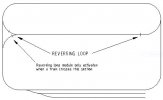(Posted here rather than Controls, Signals and Electronics because it's DCC-specific)
Consider the reversing loop configuration in this post.
Consider the reversing loop configuration in this post.
- Wye junction off the mainline
- Yards at the far end of the wye
- DCC automatic reversing section from wye to approach to yards. Reversing section has 3 entries - 2 on "branches" of wye (not on mainline) and third near the yards.
- Consider the branches of the wye. Is it beneficial for the cuts to be close to the base (branches outside reversing section) or the ends of the branches (maximum length in reversing section)?
- A traditional reversing loop naturally resists having multiple trains in the loop, since the single line leading to the reversing loop naturally supports only a single train. In this scenario, you could easily have a train operating on the yard end and a train entering or leaving the mainline, thus bridging both ends of the reversing section. What sort of interlock could be easily implemented to strictly enforce the "only one train" requirement.


